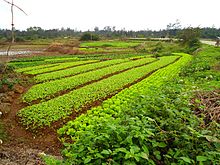Products

Mono-Ammonium Phosphate (MAP)
N: 11% P: 21.9% S: 1.5% Crop Segments: All Nitrogen and phosphorus combined in one granule. It is one of the major cropping fertilisers used as a source of phosphorus and nitrogen, MAP and MAP blends are used extensively in cropping systems and for sowing pastures. The low level of nitrogen makes it useful as a ‘starter’ fertiliser and as there is no free ammonia, the risk of affecting germinating seeds is minimal. MAP is used as a feed ingredient for animals. The NH4+ is synthesized into protein and the H2PO4- supports a variety of metabolic functions in animals. Restrictions For sowing there is little risk of affecting germination, even at high rates. As a general rule, a maximum of 20kg/ha of nitrogen at seeding of cereals should be used. When applying MAP, the fertiliser should be banded 5cm away from the seed, either below or to the side. MAP is low in sulphur (1%). It is not recommended for high sulphur requiring crops such as canola, unless blended with sulphate of ammonia or other sulphur source. Do not store in silos. Urea (46) N: 46% Crop Segments: All High analysis form of nitrogen, used as a straight fertiliser and in blends. Plants take up nitrogen from the soil in the mineral forms of nitrogen, both ammonium and nitrate before converting it to plant protein nitrogen. Plants vary in their preference to utilise either form of nitrogen. Nitrate is considered the main source because it is mobile in the soil. On addition to the soil, Urea dissolves into the soil solution and is converted to ammonium and then to nitrate.
Learn More
Urea (46)
N: 46% Crop Segments: All High analysis form of nitrogen, used as a straight fertiliser and in blends. Plants take up nitrogen from the soil in the mineral forms of nitrogen, both ammonium and nitrate before converting it to plant protein nitrogen. Plants vary in their preference to utilise either form of nitrogen. Nitrate is considered the main source because it is mobile in the soil. On addition to the soil, Urea dissolves into the soil solution and is converted to ammonium and then to nitrate. Urea can be an effective source of protein in beef cattle diets. Urea is a non-protein nitrogen compound. That is, the nitrogen portion of urea is used as the building block for the production of protein by rumen microbes. Cattle and other ruminants convert urea to protein through the production of ammonia and carbon dioxide. Restrictions Do not mix Urea with Single Superphosphate or Triple Superphosphate. Do not store in silos. Careless use of urea as a feedstuff can bring on poor feed efficiency, metabolic troubles (especially seen at parturition in cows), central nervous system disorders and death.
Learn More
Calcium Ammonium Nitrate (CAN 28%)/Limestone Ammonium Nitrate (LAN 28)
CAN/LAN contains 28% nitrogen of which 50% as ammonium and 50% as nitrate. Both forms are readily available for plant uptake. The 50/50, nitrate-N/ammonium-N ratio is close to the preferred ratio for most crops. Ammonium nitrate's advantage over urea is that it is more stable and does not rapidly lose nitrogen to the atmosphere Crop Segments: All The nitrate form moves readily with soil water to the roots, where it’s immediately available for plant uptake. The ammonium fraction is taken up by roots or gradually converted to nitrate by soil microorganisms. Many vegetable growers prefer an immediately available nitrate source of plant nutrition and use ammonium nitrate. Animal farmers like it for pasture and hay fertilization since it’s less susceptible to volatilization losses than urea-based fertilizers when left on the soil surface. It is largely used for leaf growth of plants; because of its high crop recovery, its ease of use, and its suitability for in-season top dressing, ammonium nitrate is widely used. Restrictions Ammonium nitrate is commonly mixed with other fertilizers, but these mixtures can’t be stored for long periods because of a tendency to absorb moisture from the air. You can edit all of this text and replace it with what you want to write.
Learn More
Muriate of Potash (MOP)
K: 50 % Crop Segments: All Most economic form of soluble potassium. Potassium is supplied in chloride form. Not ideally suited to situations where soil salinity/sodicity exist or for where high salt level irrigation waters are utilised. MOP is used extensively for fertilising pastures, sugar cane, fruit trees, vegetables, and other field crops. Restrictions MOP should not be used on salt sensitive crops, where soil salt levels are high or increasing, or where irrigation water has high salt levels. Do not place MOP near seed unless the seed has been protected by lime-coating or inoculation. Do not store in silos.

Sulphate of Potash (SOP) or Potassium Sulphate
K: 41.5% S: 17% Crop Segments: All Contains no chloride and provides a good source of sulphur. It has a low salt index. Potassium sulphate (SOP) can be a more expensive source of potassium than MOP and so its uses are often restricted to five main areas. Where soil or irrigation water salt levels are high and MOP is undesirable. Where chloride sensitive crops are being grown; for example, berries and vines. Where high chloride levels occur in irrigation water. Restrictions Do not store in silos

Various grades of blended NPK Fertilizers
NPK fertilizer is primarily composed of three main elements: Nitrogen (N), Phosphorus (P), and Potassium (K), each of these being essential in plant nutrition. Among other benefits, Nitrogen helps plants grow quickly, while also increasing the production of seed and fruit, and bettering the quality of leaf and forage crops. Nitrogen is also a component of chlorophyll, the substance that gives plants their green colour, and also aids in photosynthesis. Phosphorus, also a key player in the photosynthesis process, plays a vital role in a variety of the things needed by plants. Phosphorus supports the formation of oils, sugars, and starches. The transformation of solar energy into chemical energy is also aided by phosphorus, as well as is development of the plant, and the ability to withstand stress. Additionally, phosphorus encourages the growth of roots, and promotes blooming. Potassium, the third essential nutrient plants demand, assists in photosynthesis, fruit quality, the building of protein, and the reduction of disease. Nutri SA produces various NPK Blends for but not limited to Sugar cane; maize; and tobacco

Prescription blends
Nutri SA offers a prescription blending service to growers through its extensive dealer network. Prescription blending combines a range of fertilisers to supply the exact nutrients required for your crop, paddock and growth stage. Nutrient requirements can be assessed from soil and leaf testing, agronomist advice, local agriculture department recommendations, past history or dealer experience in the area. Specialist products can be used to refine your prescription blends for maximum nutrient uptake, depending on your crop or pastures’ individual needs. Prescription blend requests are usually available rapidly. Your prescription blend will be kept on file and can be re ordered at any time.

Ammonium sulphate
Ammonium sulphate is used primarily where there is a need for supplemental N and S to meet the nutritional requirement of growing plants. Since it contains only 21% N, there are other fertilizer sources that are more concentrated and economical to handle and transport. However, it provides an excellent source of S (24%) which has numerous essential functions in plants, including protein synthesis.

Macro and Mictronutirants
Sulphur, Iron, Molybdenum, Iron, Boron, Zinc, Copper, Manganese and etc



